The vibrant flavors of red curry, loads of garlic, ginger, basil, and coconut milk, make every spoonful of red curry coconut shrimp stew a savor-worthy experience.
And it cooks in just 30 minutes, so dinner is done fast!
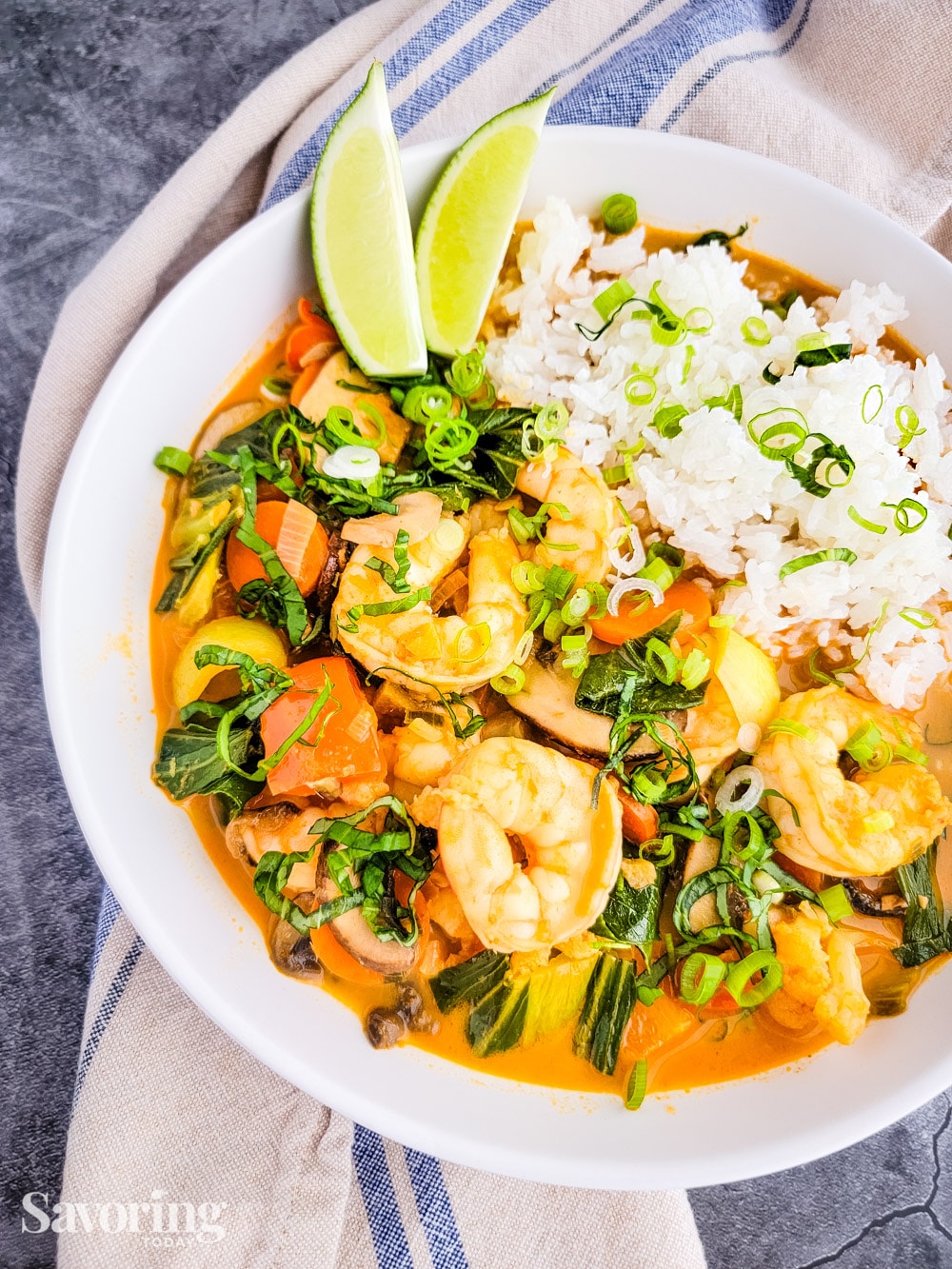
Packed with fresh vegetables, tender shrimp, and a big Thai flavor, this recipe is healthy and satisfying comfort food you’ll look forward to in the dinner rotation.
I do love a dish that remains complex and unique in the face of becoming what you might call “a kitchen sink” recipe. Inspired by some of my favorite Thai takeout dishes, a craving for easy comfort food, and the tireless drive to use ALL of the groceries, curry is my tried-and-true last-minute recipe right hand.
In the past, I typically reached for yellow curry powder, which has a mellow, almost sweet flavor with an earthy turmeric backbone.
And while I still love our Vegetable Curry Recipe, I have officially converted to the red curry fan club for its warming intensity and how it makes this shrimp stew come to life.
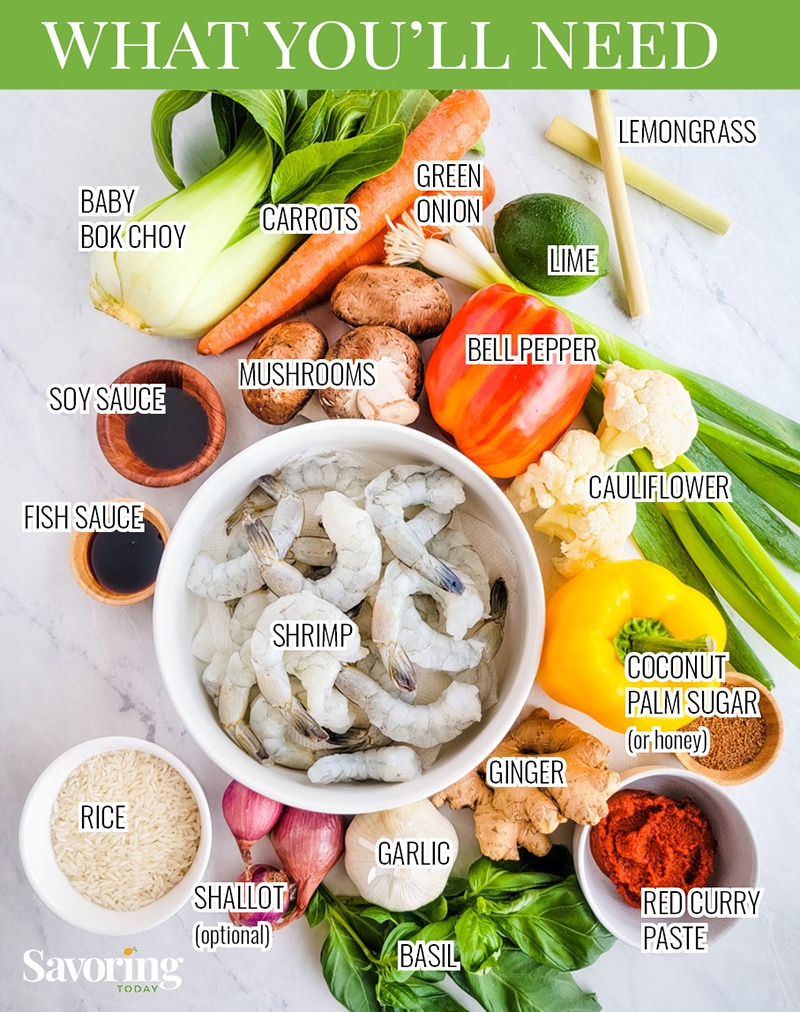
What is Red Curry Made With?
Red curry, commonly referred to as the spicy curry, is a distinct blend of red chilis, coriander, cumin, galangal, lemongrass, ginger, garlic, and kaffir lime.
Because the ingredients are fresh rather than dried, red curry comes in a fragrant and deeply flavorful paste, able to boldly enrich any dish.
It is widely used in Thai cuisine and often paired with coconut milk.
Creamy coconut milk cools off the heat in the curry to create a wonderfully satisfying broth that warms the bones. Mmm, can you almost taste it?!
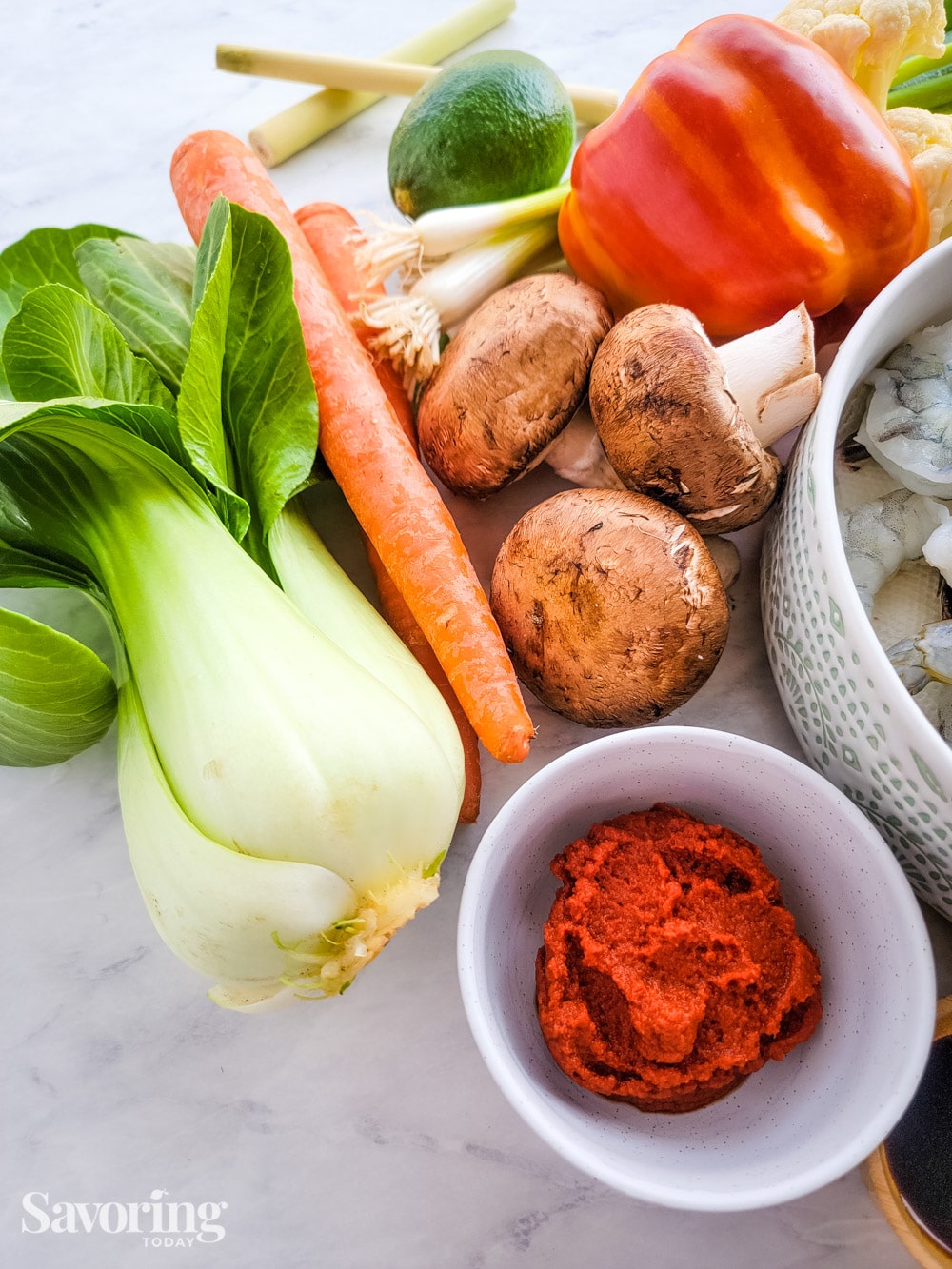
Which curry paste should I use?
You do not want curry sauce or powder—be sure to get red curry paste—it is a vital ingredient in this stew.
I highly recommend Thai Kitchen curry paste because it has consistently balanced flavors, and it is available at most grocery stores in the international food aisle.
But don’t be afraid to branch out with Mae Ploy, Maesri, Aroy-D, or A Taste of Thai, which are all good options for delicious flavor and heady spice in a curry recipe.
PRO TIP: Go slow. Different brands have different spice levels. I can add a generous scoop of the Thai Kitchen Red Curry Paste into a recipe, but that is not the case with Mae Ploy. If you treat them the same, you’ll have a surprisingly spicy time.
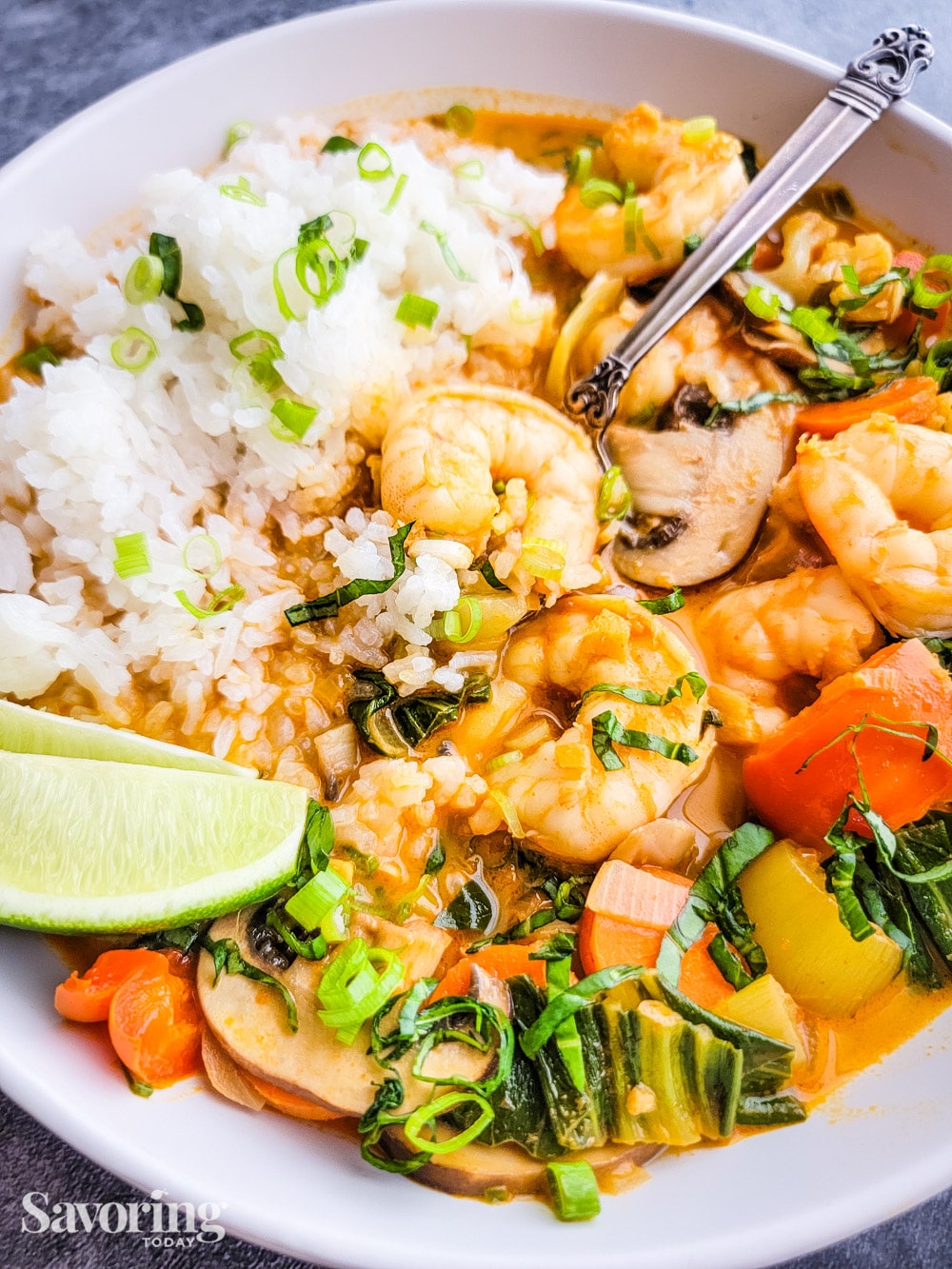
Can I make my own curry paste?
Yes! I encourage you to make your own at least once, and here’s a tasty red curry paste recipe you can try.
It is always valuable to know exactly what is in a food you love, and making your own curry gives you control of every level of flavor in the curry.
Maybe you want to bump up the lemongrass, the spice, or the galangal. Because it’s made with fresh ingredients, a mortar and pestle or food processor certainly makes creating your own red curry paste easier.
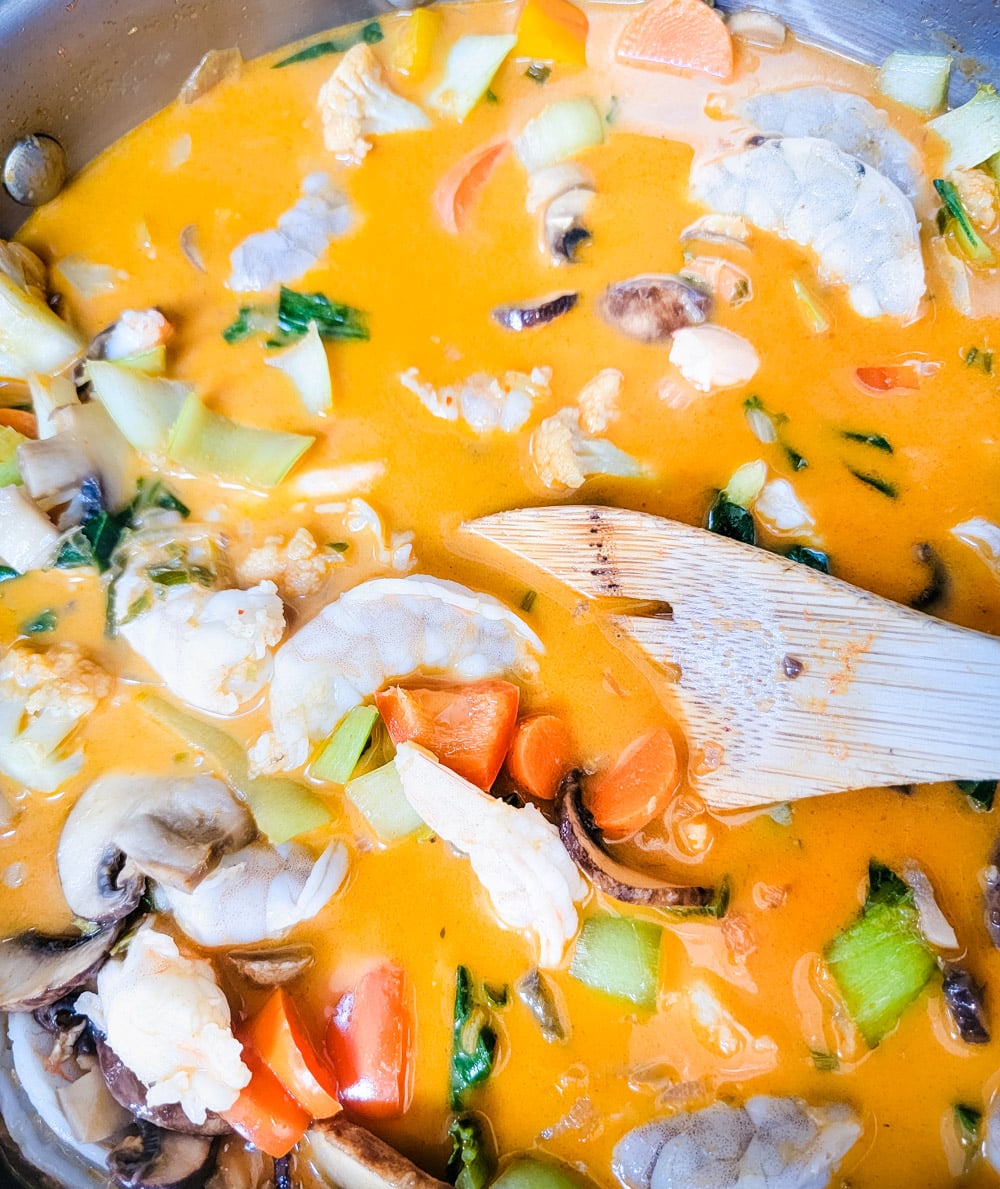
How to Choose and Use Shrimp:
Fresh or Frozen?
Based in the lovely landlocked state of Colorado, all the shrimp I have access to is either frozen or has been frozen, as is the case with most non-coastal grocery stores.
You may be tempted to pick up “fresh” shrimp from the seafood counter so you won’t have to defrost them, which is fine, just be sure you’ll be using them right away.
Once shrimp are defrosted, they should be used within 2 days (sooner is better).
The downside of buying defrosted shrimp at the store is not knowing how long those thawed shrimp have been sitting out, and with highly perishable seafood, the better bet is simply a bag of frozen shrimp. This way, you can quickly defrost them (in less than 20 minutes) when you want to use them.
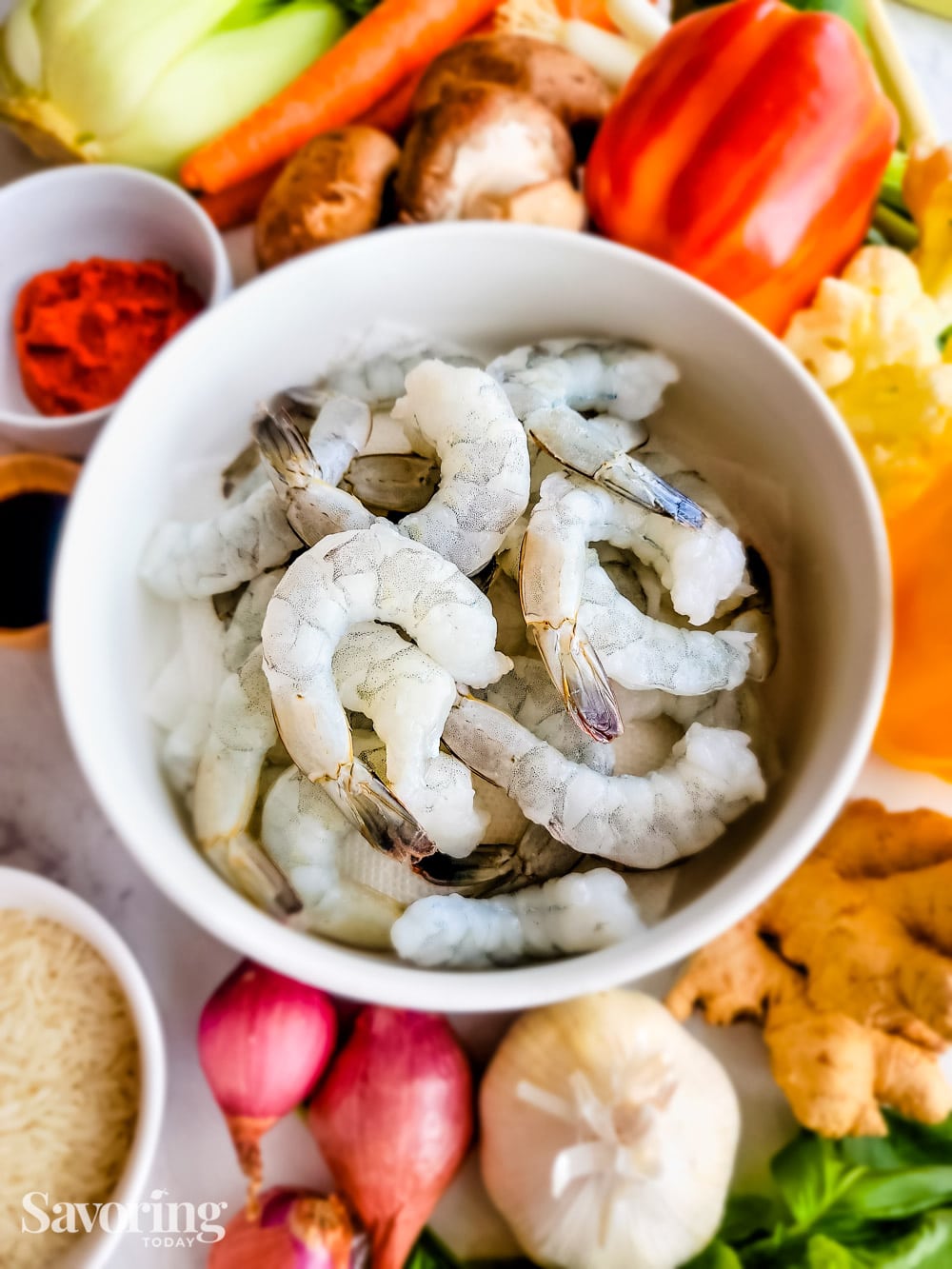
This post may contain affiliate links. See our disclosure policy for more information.
Shrimp With or Without the Shell?
Well, it depends! Buying shrimp with the shell on tends to be less expensive and imparts more flavor when cooked. And if you peel them yourself, you can use the shells for fish stock. Some folks would even say peeling shrimp is fun—and there’s a handy shrimp cleaning tool to make it easier.
However, buying shrimp already peeled and deveined can save prep time and allows you to see that the flesh is plump and not muddy in appearance. Of course, saving your own time means paying a little more for someone else’s labor.
Clearly, there are advantages either way, depending on the recipe.
I recommend buying a bag of individually quick-frozen shrimp (IQF), shell on, head off, and deveined. (Although the heads can be a nice addition when making fish stock.)
In this red curry shrimp stew, we remove the shells and tails before cooking the shrimp simply because wrangling tails when you’re trying to eat is not a good time.
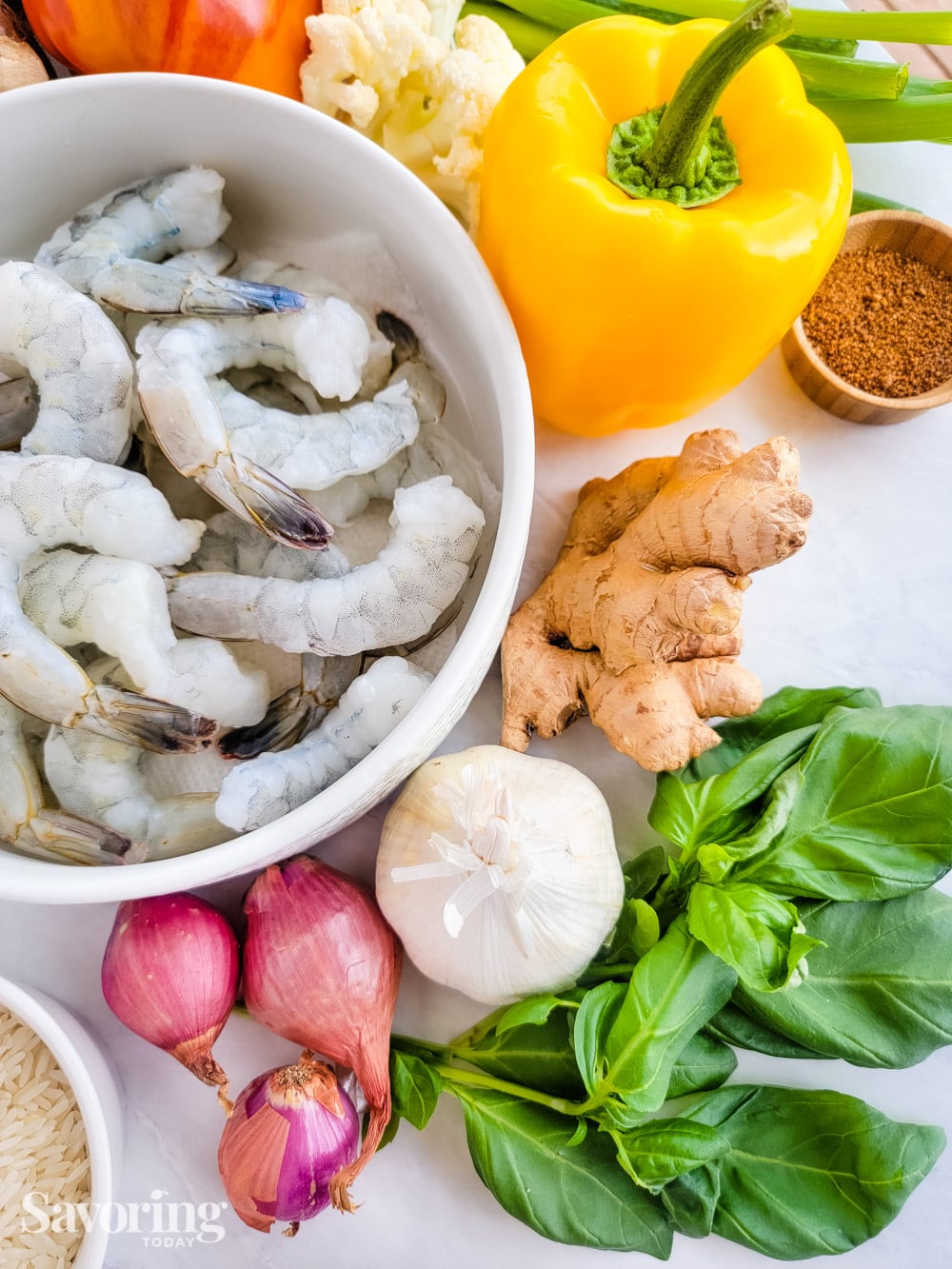
What Does Shrimp Count Mean?
Shrimp size is dictated by the number it takes to make one pound of shrimp. Labels usually read something like 18/22 or 36/50, which means 18 to 22 shrimp in a pound or 36 to 50 shrimp in a pound. The smaller the number, the larger and fewer shrimp per pound.
The letter U before a number (like U15) means there will be under 15 count shrimp in a pound, which also means those shrimp are gonna be huge! Jumbo shrimp is best used for grilling or recipes where the shrimp is eaten by itself so it can be fully appreciated and savored.
For this recipe, I chose large shrimp, typically a 21-25 count (indicated on the bag), as I enjoy the meatier texture in this application.
How To Defrost Shrimp
OVERNIGHT: The best way to defrost shrimp is to leave it in the original packaging and place it on a rimmed baking sheet or platter in the fridge overnight. TIP: Always put something under it in case it leaks.
QUICK THAW:
- Remove the shrimp from its package and spread the frozen shrimp out in the bottom of a colander.
- Run cold water over the shrimp for about 5 minutes to melt any ice glaze and begin thawing the outside.
- Allow the shrimp to sit in the colander while preparing the rest of the ingredients (about 15 minutes). If the shrimp still feels frozen in the center after 15-20 minutes, run more water over the shrimp to finish defrosting.
AVOID the following when defrosting shrimp:
- Allowing shrimp to sit out at room temperature for longer than 30 minutes
- Using hot water (shrimp can partially cook, or cook unevenly)
- Microwaving (can partially cook the shrimp and make it tough)
Do I cook the shrimp beforehand?
No. Shrimp is quick-cooking, and once the curry broth is near boiling temperature, will be added raw and then fully cooked within 5 minutes. They will also be delightfully tender and juicy!
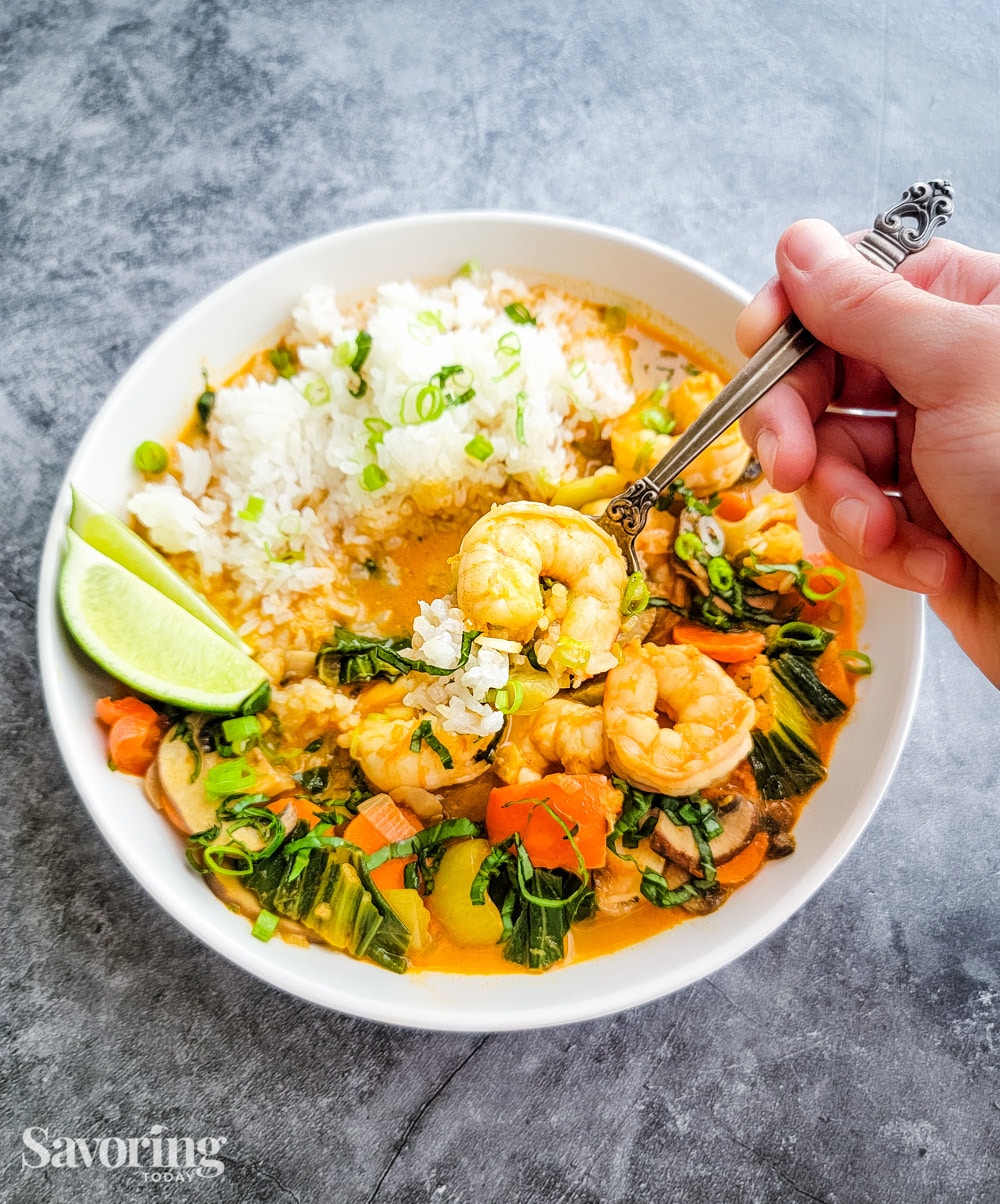
Recipe TIPS & Variations:
- To easily prep the lemongrass for the best flavor, freeze it in advance, then use a Microplane grater to mince.
- Save prep time and buy shrimp already peeled and deveined and prepped vegetables.
- Make it vegetarian or vegan by subbing vegetable stock for the chicken stock and omitting the shrimp and fish sauce.
- Make it gluten-free by substituting tamari in place of soy sauce and using gluten-free fish sauce (Golden Boy or Red Boat)
- Use different vegetables. ANY vegetable can work; just keep in mind that root vegetables and heartier greens tend to need a longer cook time or cut into smaller pieces. Things like parsnips, butternut squash, broccoli and cauliflower stems, collard greens, squash, and especially potatoes might need a pan sear or longer cook time.

STEP BY STEP
- Melt coconut oil in a deep skillet over medium-high heat.
- Add shallots and onion and cook for 6-8 minutes until translucent and browning at the edges. Add garlic and ginger to the skillet and cook for 2 more minutes.
- Add red curry paste, salt, and pepper, stir to integrate, and cook until fragrant, about 1 minute.
- Add the stock, coconut milk, soy sauce, fish sauce, honey, and lemongrass. Stir and bring the broth to a low boil. Simmer for 5 minutes to reduce slightly and thicken the broth.
- Add all the chopped vegetables and bring them up to a boil; simmer for 5 minutes.
- Add the shrimp and simmer for 5 minutes. Taste and adjust seasoning (salt, sweet, spice) as desired.
- Serve in shallow bowls with rice and a lime wedge to squeeze over the top. Garnish with fresh basil and scallions.
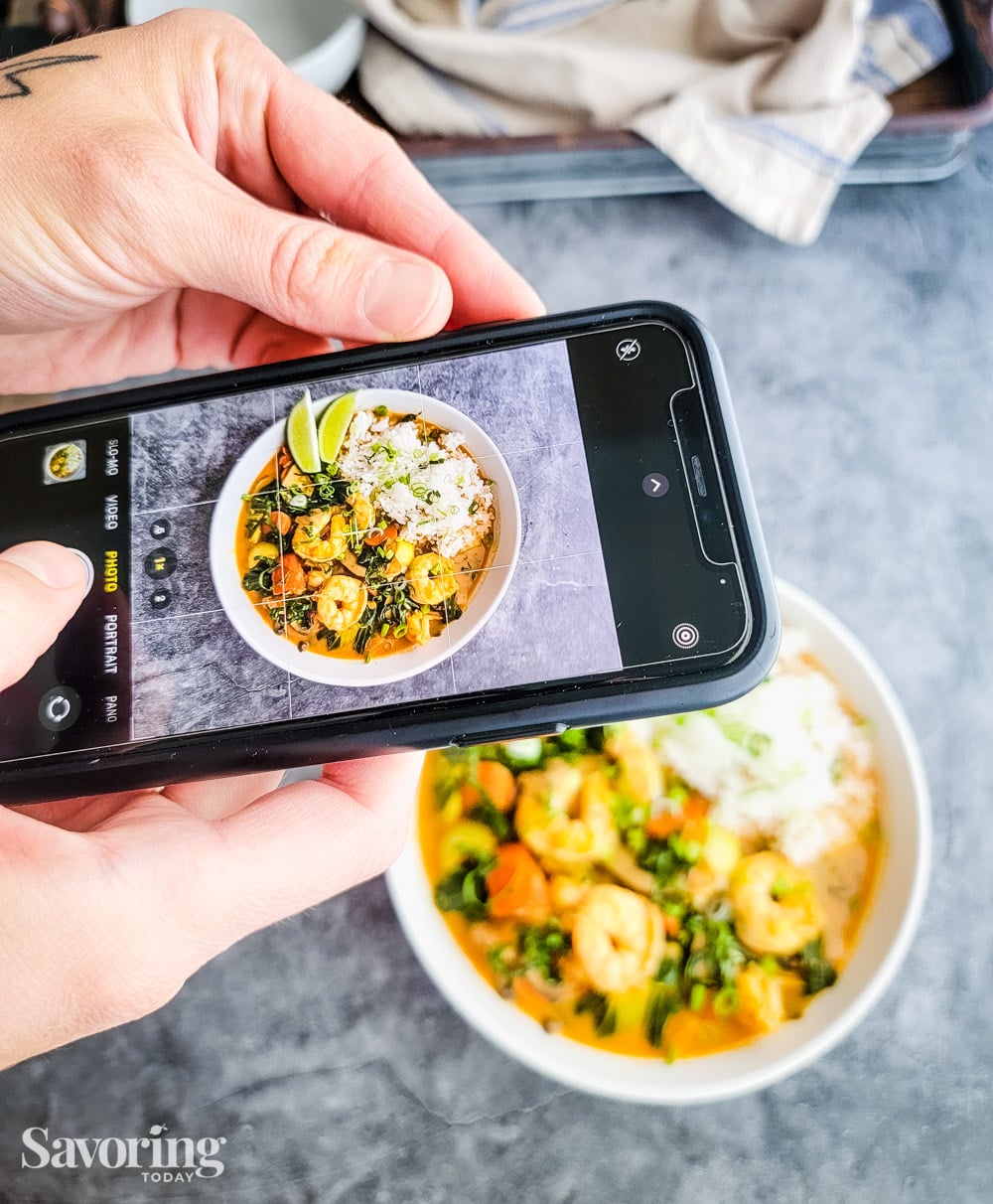
More Soup and Stew Recipes You’ll Love
- Savory Pumpkin Soup with Cotija Cheese & Toasted Pepitas
- Creamy Italian Meatball Soup
- Vegetable Thai Curry with Jasmine Rice
- Chicken Stew with Parmesan Dumplings
- Seafood Chowder with Clams, Shrimp, & Fish
- Sausage and Split Pea Stew
- Tri-Tip Steak Chili
- Basic Chicken Curry
Red Curry Coconut Shrimp Stew
Ingredients
- 2 tablespoons coconut oil
- 1 large shallot or small onion, chopped fine
- 3 green onions , chopped fine (save scallions for garnish)
- 4 cloves garlic , minced
- 1 tablespoon minced fresh ginger , about a 2-inch knob
- 1 teaspoon sea salt
- 1 teaspoon freshly ground pepper
- 3 tablespoons Red Curry Paste , to taste (Thai Kitchen)
- 2 cups chicken broth , or fish stock
- 15 ounces coconut milk
- 2 tablespoons soy sauce
- 1 tablespoon fish sauce or more, to taste
- 2 teaspoons coconut palm sugar , or honey
- 1 tablespoon microplaned lemongrass , or minced fine
- 1 small bell pepper or poblano pepper, coarsely chopped
- 8 ounces cremini mushrooms , sliced
- 1 large carrot , peeled, thinly sliced
- 1 head baby bok choy , coarsely chopped
- 1 cup chopped cauliflower
- 1 pound shrimp , peeled, deveined, and tails removed
- 1 large lime , cut into 8 wedges
- Chopped basil and scallions , to garnish
- FOR THE RICE:
- 1 cup jasmine or basmati rice
- 1 3/4 cup water
- 2 tbsp butter
- 1/2 tsp salt
Instructions
- FOR THE RICE:
- No-fail rice method: Soak rice in water for 10 minutes, then transfer it to a mesh strainer and rinse with cold water until the stream coming from the strainer is clear. Add the rice, water, butter, and salt to a saucepan with a tight-fitting lid, and stir all ingredients together over high heat. Once it reaches a boil, turn down the heat to a simmer (I usually use a low+ setting), cover with the lid, and cook for 20 mins. After 20 minutes, turn the heat to high for 10 seconds, then slide the pan off the heat and let it sit (covered) for 10 more minutes.
- FOR THE STEW:
- In a saute pan over medium-high heat, melt coconut oil to cover the bottom of the pan. Add the shallots and green onion and cook for 6-8 minutes until translucent and browning at the edges. Add garlic and ginger to the skillet and cook for 2 more minutes.
- Add a good sprinkle of salt and pepper and the red curry paste, stir to integrate and cook until fragrant about 1 minute. (More curry paste can be added, to taste.)
- Add the stock, coconut milk, soy sauce, fish sauce, sugar, and lemongrass. Give everything a good stir and bring the broth to a low boil. Let it simmer for 5 minutes to reduce slightly and thicken the broth.
- Add all the chopped vegetables and bring it back up to a boil; simmer for 5 minutes.
- Add the shrimp and simmer for 5 minutes. Taste and adjust seasoning (salt, sweet, spice) as desired.
- Serve in shallow bowls with rice and a lime wedge to squeeze over the top. Garnish with fresh basil.
Notes
- To easily prep the lemongrass for the best flavor, freeze first, then use a microplane grater to mince.
- Save prep time and buy shrimp already peeled and deveined and prepped vegetables.
- Vegan/Vegetarian: Use vegetable stock and no shrimp.
- Gluten-Free: Use Tamari to replace soy sauce & gluten-free fish sauce (Golden Boy or Red Boat)
Nutrition

Article by Kayla Purcell
Kayla’s creativity spills over into everything she does, especially in the kitchen. She is passionate about bringing people together around tasty food that’s good for you. We love that too.
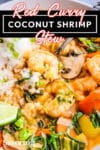
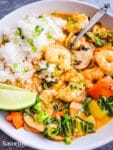
John / Kitchen Riffs says
Wow, what a terrific dish! This is just loaded with fabulous flavor. Thanks!